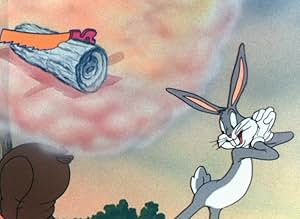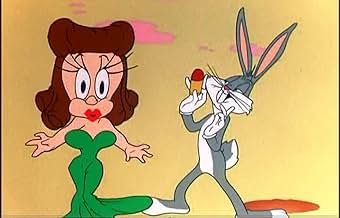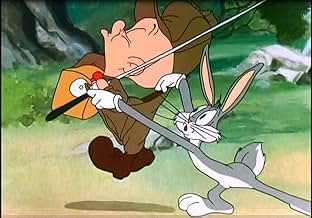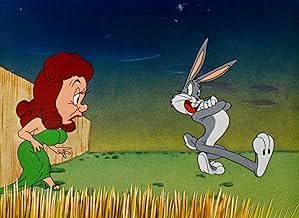Aggiungi una trama nella tua linguaElmer Fudd walks out of a typical Bugs cartoon, so Bugs gets back at him by disturbing Elmer's sleep using "nightmare paint."Elmer Fudd walks out of a typical Bugs cartoon, so Bugs gets back at him by disturbing Elmer's sleep using "nightmare paint."Elmer Fudd walks out of a typical Bugs cartoon, so Bugs gets back at him by disturbing Elmer's sleep using "nightmare paint."
- Regia
- Sceneggiatura
- Star
- Premi
- 1 candidatura in totale
- Bugs Bunny
- (voce)
- …
- Elmer Fudd
- (voce)
- (non citato nei titoli originali)
Recensioni in evidenza
I like the turn and going meta. I am less convinced of the dreamland sequence. I can think of many ideas for dreams including Elmer Fudd turning into a rabbit being chased by Bugs Bunny dressed as a hunter. Most of all, I don't buy the ending. If he gets hounded by Bugs in his nightmare, he would never go back to his job. This is adventurous although I have questions.
At the beginning of this cartoon, then, it is significant that we see that Elmer Fudd is becoming disenchanted with his cartoon contract with "Mr. Warner" and tears it up in frustration after once again being the fall guy for Bugs Bunny. What follows is a surreal sequence after Elmer falls asleep. Bugs uses "nightmare paint" to make him dream so Bugs can manipulate him in his slumber to save both of their careers. We have the usual assortment of corny Clampett gags mixed in with some stunning scenes that must have had everyone back in 1946 scratching their heads a little, wondering if Clampett had finally lost his mind. The price that innovative people sometimes have to pay is that not everyone will get it, and I don't think Selzer was anywhere near "getting it", so Clampett got the door.
In a shrewdly self-referential twist on the usual formula, Elmer, after being outsmarted by the mischievous Bugs for the last time, angrily tears up his Warner Bros. contract and decides to spend the rest of his days fishing. Fearing for his own career, Bugs attempts to frighten Elmer back into acting, and does so by entering into his dreams and systematically turning them into a string of terrifying nightmares, plagued by horrific armies of annoying "wabbits." With the realisation that retirement isn't quite as peaceful as he'd anticipated, Elmer promptly returns to the film set and accepts that it is simply his duty to be consistently suckered by a rascally rabbit. Just as the classic 'Duck Amuck (1954)' derived humour from its self-referential nature, Clampett's film {ironically enough, the last that he made for Warner Bros.} has some fun with the conjecture that Elmer Fudd is a contracted actor on the studio's payroll. The dream sequence is colourful, chaotic and suitably threatening, and Bugs appears to get a lot of enjoyment from tormenting the hapless little hunter.
Lo sapevi?
- QuizElmer tears up his contract with Warners and leaves. This cartoon was also the last made by Robert Clampett before he left Warners, though there were some others in the pipeline that came out later.
- BlooperAfter the dream, Elmer arrives back at the log in a rush and the pieces of contract blow about in the air. A nearly off-screen Bugs on the left looks like he mouthes his catchphrase: "Ehhhh, What's up Doc?", but there is no sound.
- Citazioni
Bugs Bunny: [trying to convince Elmer not to leave] No. No, doc. You can't do this to me. Think of what we've been to each other. Why, we've been like... like Rabbit and Costello, Damon and Runyon...
[tugs at Elmer's pants]
Bugs Bunny: Stan and Laurel...!
[rips them off accidentally]
Bugs Bunny: Uh-oh!
[He puts them back on]
Bugs Bunny: You can't do this, I tell ya. You don't want to break up the act, do ya?
[aside to audience]
Bugs Bunny: Bette Davis is gonna hate me for this.
[back to Elmer]
Bugs Bunny: Think of your career.
[turns back to audience, shocked]
Bugs Bunny: And for that matter, think of my career.
[breaks down in tears]
- Versioni alternativeOne version omits the scene where Bugs Bunny takes the sleeping pills (possibly an act of political correctness). This scene is left intact in the 2004 Looney Tunes 4-disc box set.
- ConnessioniEdited from All This and Rabbit Stew (1941)
I più visti
Dettagli
- Tempo di esecuzione7 minuti
- Mix di suoni
- Proporzioni
- 1.37 : 1
Contribuisci a questa pagina





















